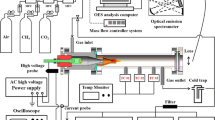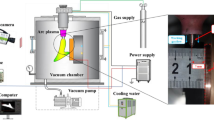Abstract
In this study, the characteristic behavior of a rotating arc was investigated. Various modes, depending on the electric power supplied, can be observed in a rotating arc. Each mode produces different discharge characteristics and thermal environments and, accordingly, chemical processes hosted in the plasma reaction volume can be controlled differently in each mode. General thermal to non-thermal transitions observed in a gliding arc are based on the longitudinal expansion of the arc column. In a rotating arc, the reverse transition or non-thermal to thermal transition can be hosted by controlling the reactor geometry. The reverse transition can be achieved by self-adjustment of the arc column where longitudinal expansion of the arc column is confined. The reverse transition enhances the conversion efficiency of electric power to thermal energy. Then, optimization of thermal activation was obtained by controlling the mode of operation, and it was verified using the NH3 decomposition reaction.











Similar content being viewed by others
References
Fridman A, Kennedy L (2004) Plasma physics and engineering. Taylor and Francis, New York
Fridman A (2008) Plasma chemistry. Cambridge University Press, New York
Petitpas G, Rollier J-D, Darmon A, Gonzalez-Aguilar J, Metkemeijer R, Fulcheri L (2007) A comparative study of non-thermal plasma assisted reforming technologies. Int J Hydrogen Energy 32(14):2848–2867
Urashima K, Chang J-S (2000) Removal of volatile organic compounds from air streams and industrial flue gases by non-thermal plasma technology. IEEE Trans Dielectr Electr Insul 7(5):602–614
Yao SL, Takemoto T, Ouyang F, Nakayama A, Suzuki E, Mizuno A, Okumoto M (2000) Selective oxidation of methane using a non-thermal pulsed plasma. Energy Fuels 14(2):459–463
Lee DH, Kim KT, Song YH, Kang WS, Jo SK (2013) Mapping plasma chemistry in hydrocarbon fuel processing processes. Plasma Chem Plasma Process 33:249–269
Lee DH, Kim K-T, Cha MS, Song Y-H (2010) Plasma-controlled chemistry in plasma reforming of methane. Int J Hydrogen Energy 35:10967–10976
Heberlein J, Murphy AB (2008) Thermal plasma waste treatment. J Phys D Appl Phys 41:053001
Fujita S, Toyoshima H, Nishihara M, Sasaki A (1982) Variations of trap states and dangling bonds in CVD Si3N4 layer on Si substrate by NH3/SiH4 ratio. J Electronic Mat 11(4):795–812
Lee DH, Kim K-H, Cha MS, Song Y-H (2007) Optimization scheme of a rotating gliding arc reactor for partial oxidation of methane. Proc Combust Inst 31:3343–3351
Lee DH, Kim K-T, Cha MS, Song Y-H (2010) Effect of excess oxygen in plasma reforming of diesel fuel. Int J Hydrogen Energy 35:4668–4675
Lee DH, Lee J-O, Kim K-T, Song Y-H, Kim E, Han H-S (2012) Hydrogen in plasma-assisted hydrocarbon selective catalytic reduction. Int J Hydrogen Energy 37:3225–3233
Mutaf-Yardimci O, Saveliev AV, Fridman AA, Kennedy LA (2000) Thermal and nonthermal regimes of gliding arc discharge in air flow. J Appl Phys 87:1632–1637
Kuo KK (1986) Principles of combustion. Wiley, New York
Rusu I, Cormier J-M (2003) On a possible mechanism of the methane steam reforming in a gliding arc reactor. Chem Eng J 91:23–31
Fridman A, Nester S, Kennedy LA, Saveliev A, Mutaf-Yardimci O (1999) Gliding arc gas discharge. Prog Energy Combust 25:211–231
Fridman A, Czernichowski A, Chapelle J, Cormier JM, Lesueur H, Stevefelt J (1993) Int Symp On Plasma Chem, ISPC 11, Loughborough
Raizer IuP (1987) Gas discharge physics. Springer, Berlin
Chelouah A, Marode E, Hartmann G, Achat S (1994) A new method for temperature evaluation in a nitrogen discharge. J Phys D Appl Phys 27:940–945
Nassar H, Pellerin S, Musiol K, Martinie O, Pellerin N, Cormier J-M (2004) N2+/N2 ratio and temperature measurements based on the first negative N2+ and second positive N2 overlapped molecular emission spectra. J Phys D Appl Phys 37:1904–1916
Acknowledgments
This work is supported by ISTK (Korea Research Council for Industrial Science and Technology) of the Republic of Korea, Grant number B551179-11-03-00.
Author information
Authors and Affiliations
Corresponding author
Rights and permissions
About this article
Cite this article
Lee, D.H., Kim, KT., Kang, H.S. et al. Optimization of NH3 Decomposition by Control of Discharge Mode in a Rotating Arc. Plasma Chem Plasma Process 34, 111–124 (2014). https://doi.org/10.1007/s11090-013-9495-z
Received:
Accepted:
Published:
Issue Date:
DOI: https://doi.org/10.1007/s11090-013-9495-z




